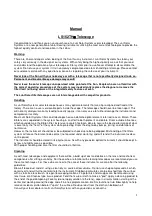
and are thought to have been pulled apart
because they passed too close to—or even
through—a larger galaxy.
You may be able to see the Andromeda
galaxy and several others in your telescope.
They will appear as small, fuzzy clouds. Only
very large telescope will reveal spiral or
elliptical details.
You will also be able to see some nebulas
with your scope. Nebula means cloud. Most
nebulas are clouds of gas. The two easiest to
see in the Northern Hemisphere are the
Orion nebula during the winter and the
Triffid nebula during the summer. These are
large clouds of gas in which new stars are
being born. Some nebulas are the remains
of stars exploding. These explosions are
called supernovas.
When you become an advanced observer you
can look for other types of objects such as
asteroids, planetary nebula and globular
clusters. And if you’re lucky, every so often a
bright comet appears in the sky, presenting
an unforgettable sight.
The more you learn about objects in the sky,
the more you will learn to appreciate the
sights you see in your telescope. Start a
notebook and write down the observations
you make each night. Note the time and the
date.
Use a compass to make a circle, or trace
around the lid of a jar. Draw what you see in
your eyepiece inside the circle. The best
exercise for drawing is to observe the moons
of Jupiter every night or so. Try to make
Jupiter and the moons approximately the
same size as they look in your eyepiece. You
will see that the moons are in a different
position every night. As you get better at
drawing, try more challenging sights, like a
crater system on the moon or even a nebula.
Go your library or check out the internet for
more information about astronomy. Learn
about the basics: light years, orbits, star
colors, how stars and planets are formed,
red shift, the big bang, what are the different
kinds of nebula, what are comets, asteroids
and meteors and what is a black hole. The
more you learn about astronomy, the more
fun, and the more rewarding your telescope
will become.
SURF THE WEB
•
The Meade 4M Community:
http://www.meade4m.com
•
Sky & Telescope
:
http://www.skyandtelescope.com
•
Astronomy
:
http://www.astronomy.com
•
Astronomy Picture of the Day:
http://antwrp.gsfc.nasa.goc/apod
•
Photographic Atlas of the Moon:
http://www.lpi.ursa.edu/research/lunar_orbiter
•
Hubble Space Telescope Public Pictures:
http://oposite.stsci.edu/pubinfo/pictures.html
SOME OBSERVING TIPS
Eyepieces: Always begin your
observations using the 25mm low-
power eyepiece. The 25mm eyepiece
delivers a bright, wide field of view
and is the best to use for most viewing
conditions. Use the high-power 9mm
eyepiece to view details when observing the
Moon and planets. If the image become
fuzzy, switch back down to a lower power.
Changing eyepieces changes the power or
magnification of your telescope.
By the way, you might have noticed
something strange when you looked through
your eyepiece. Although the image is right-
9
Meade 70 AZ - AR 3/10/06 12:16 PM Page 11


























